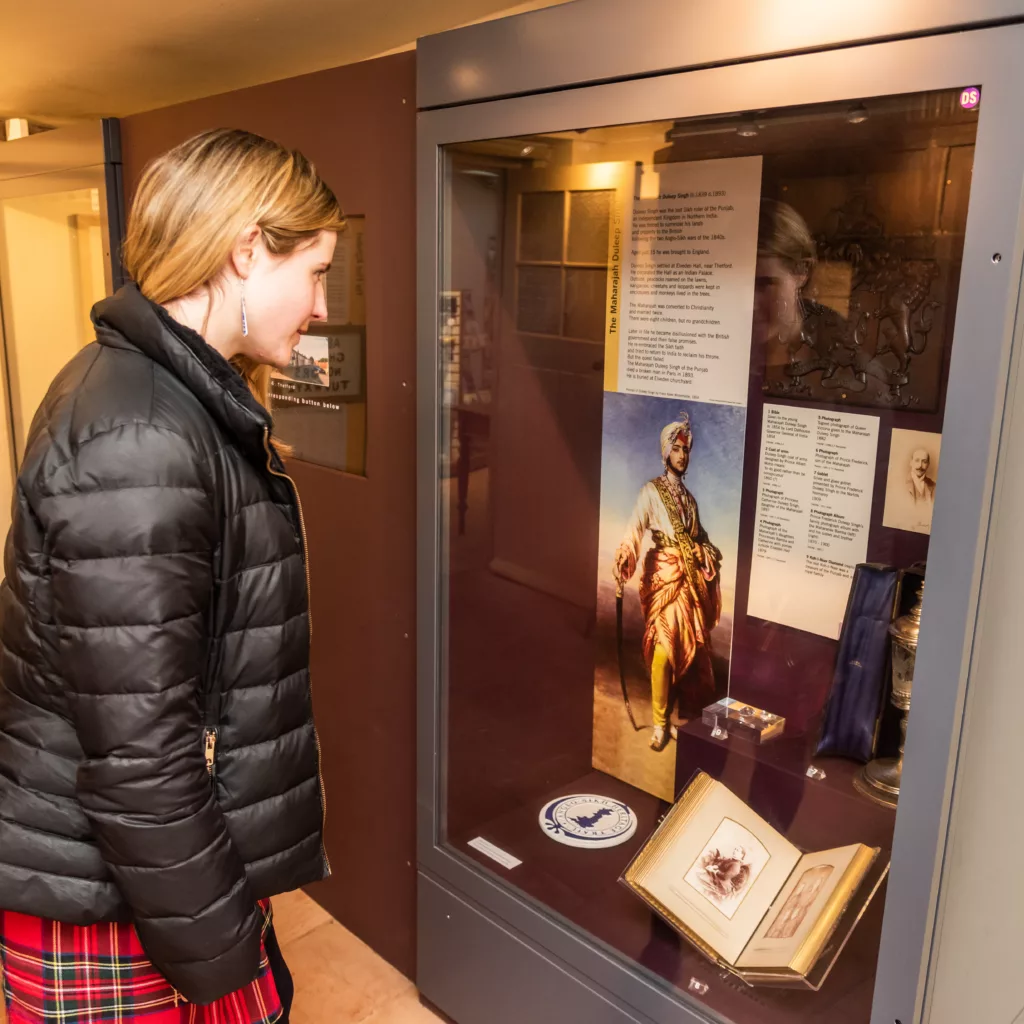
Thetford Ancient House
There are many magnificent stately homes in Norfolk but the charming Ancient House Museum in Thetford gives a unique glimpse into the history of middle class life. The early Tudor town house is one of the best examples in East Anglia. Its origins are uncertain but when the house was given as a gift to the town by Prince Frederick Duleep Singh in 1921, a conveyance mentions it was erected in the reign of Edward IV (1461-83). Probably commissioned by a wealthy merchant, it’s likely the house was originally detached, albeit constrained by the modest size of the plot.
Unlike in dramas like ‘Downton Abbey’, it was common for this kind of household, including servants, to sit down and eat together. The comfortable interior, with beautifully carved timbers, immediately captures the imagination. The Museum examines the lives of various people who lived in this building; an innkeeper, a plumber, a watchmaker and a museum caretaker. The 1901 population census tells us Thomas Newton, a rabbit warrener, was living here with his wife Emily, their family and four lodgers. If you love The Museum of the Home in London’s Shoreditch, Thetford’s Ancient House is a must-see.
Nearby there’s more history to discover. In 1737 political philosopher Thomas Paine was born 100 metres away. A passionate supporter of American and European revolutionary causes, he wrote hugely influential pamphlets including Common Sense, Age of Reason and the Rights of Man, a rebel in the great tradition of Norfolk’s radical thinkers!

Grimes Graves
Tucked away in majestic Thetford Forest there’s a mysterious lunar landscape, as if a huge meteorite shower once pounded the Breckland heath. Precisely 433 craters spread over 90 acres, strange hollows that seem hammered by a Norse god. No, not the mighty Thor but his pal, Odin. Odin’s Anglo-Saxon name is Woden, nicknamed Grim. Hence, Grimes Graves.
So was this fascinating place really created by ancient gods? The truth is, this heritage site was a Neolithic flint mine, made by humans some 5,000 years ago. In the days before our ancestors forged metal, super sharp flints were ‘knapped’ into tools, weapons and ceremonial objects. At Grimes Graves miners dug vertical shafts up to 13 metres deep and excavated narrow galleries which they crawled along, gouging out flint with pickaxes made from deer antlers. But what else might have taken place down in those dark tunnels? Animal bones and even a human skull have been found, along with evidence of underground fires, suggesting this was once a place of sacred rituals. And it’s likely what you see today is only part of the subterranean labyrinth which probably extended far under the pine forest.
Visitors can descend 9 metres (30 ft) by ladder into an excavated shaft to see the jet-black flint, which is itself another layer of deep time. Flint is the fossilised remains of soft-bodied sponges once swimming in the warm Cretaceous seas which, millions of years ago, covered the very place you now stand.
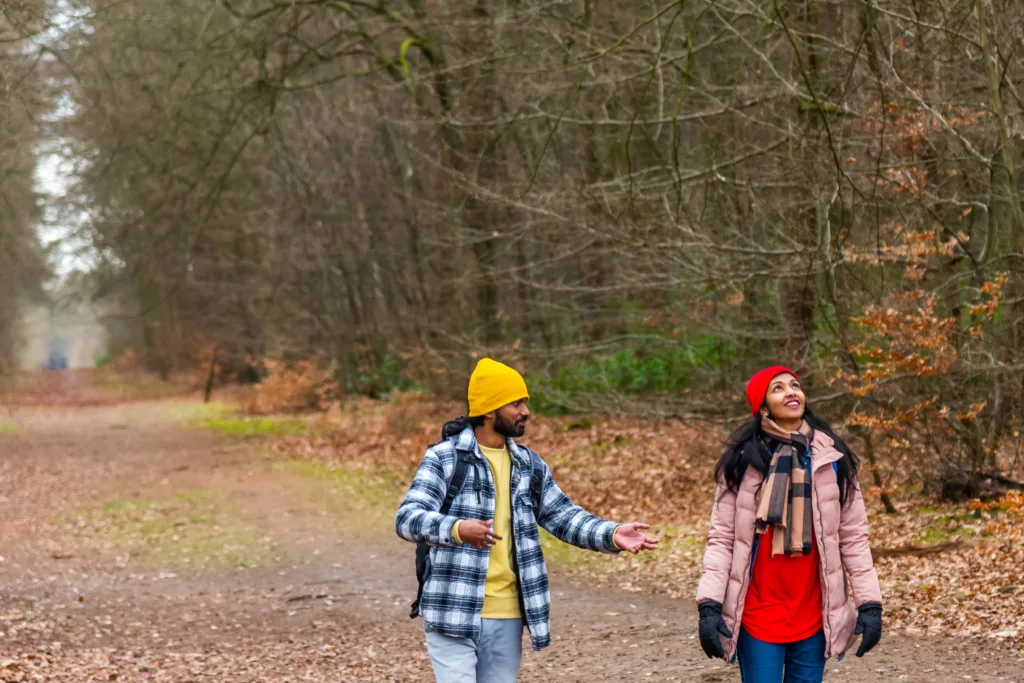
The Phantom Rabbit of Thetford
Think Black Shuck is terrifying? You ain’t seen nothing yet! Slavering hell hounds bow to Thetford’s phantom rabbit. It guards the doorway of a rare medieval rabbit warrener’s lodge, where thousands of rabbits were once raised – and killed for food and fur. If you’re wondering what could be scary about a cute little bunny, be warned that this one is a giant ghost with flaming red eyes. Oh, and seeing it is an omen of death. Just saying.
If blood-curdling rabbits aren’t hair-raising enough, some speak of an unsettling figure wandering the woodland walks around the lodge, muttering in strange dialects from a shuddering two-dimensional face. Horrifed witnesses say this chilling visage peers from the first floor window where another ghastly face is sometimes glimpsed, with gaping black holes where the eyes and mouth should be. Trouble is, there is no first floor anymore. Gulp! The lodge at Thetford was built to accommodate hunting parties on the ‘sands’ of Breckland. Perhaps that should be haunting parties?
Once this lodge was the most prolific producer of rabbit meat and skins in the county, but rabbits aren’t actually native to these islands. It’s likely they were introduced by the Romans so there’s no Old English, Celtic or Germanic word for rabbit. We’ve borrowed ours from French. There was an older term, ‘coney’, pronounced like the Irish and derived from the Latin ‘cunīculus’. It was dropped when British slang picked it up as a pun for something rather different.

Thetford Castle
In the historic market town of Thetford stands the largest earthen motte in England. Climb 40 feet and 90 steep steps to the top to see for miles across Norfolk. Here, a Norman castle once dominated the town, erected inside an ancient Iron Age earthworks. Standing at the crossings of the rivers Thet and Ouse, the Iceni tribe hill fort, dating from around 500BC, oversaw Ickneild Way, ‘the oldest road in England’. The 4,000 year old trackway connects Dorset to Norfolk along the chalk spine of England, George R.R. Martin’s inspiration for the Kingsroad in Game of Thrones.
The Domesday Book notes Thetford was England’s sixth largest town a strategic site for a Norman motte and bailey castle, believed to have been constructed in 1067, immediately after the Norman Conquest. Topped by a wooden tower encircled by a timber palisade, the Norman castle was probably built by Ralph Guader, Earl of East Anglia until he led an unsuccessful Revolt of the Earls against the Crown 1076. Or by his successor Roger Bigod (Baron Bigod cheese is named after his lordly lineage).
Only Silbury Hill in Wiltshire has a larger human-made mound, and Thetford’s is just as rich in mystery and legend. Medieval locals called it Devil’s Dyke, formed by mud falling from Satan’s filthy hoof. Others claim a king’s palace, full of treasure, lies under the hill or that six silver bells from Thetford Priory were hidden here during the Reformation, still buried deep in Norfolk earth.
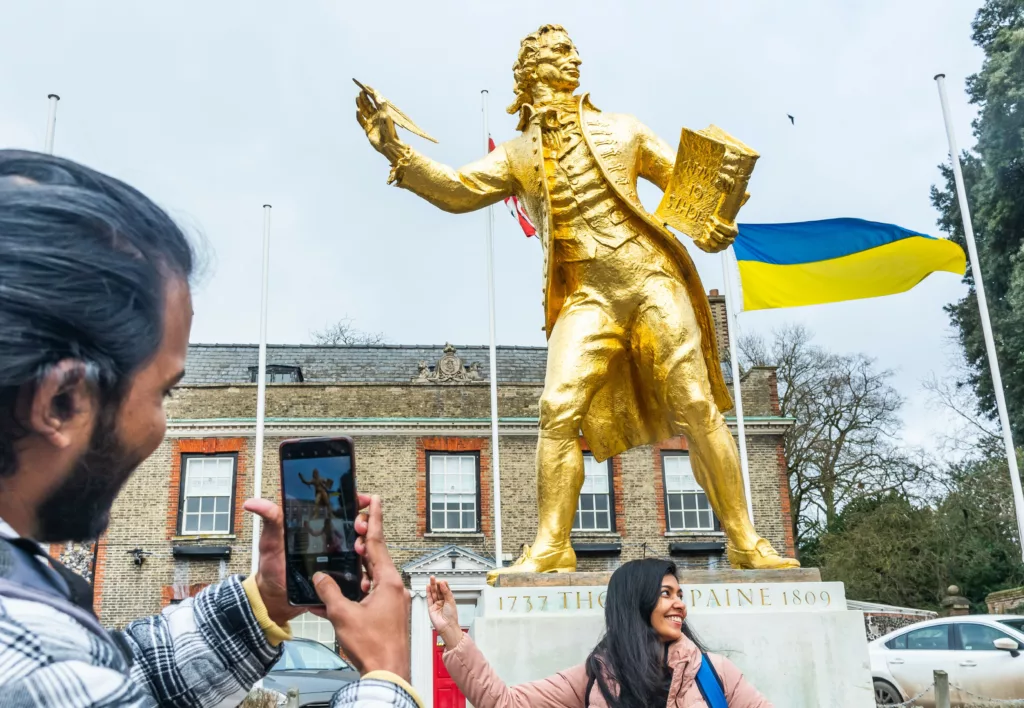
Thomas Paine – Reason to Revolution
Near to the Bell Hotel in the Breckland town of Thetford stands a monument to one of Norfolk’s greatest sons, activist and philosopher Thomas Paine, author of the ‘Rights of Man’, a defence of the French Revolution. This, amongst other rebel publications made him decidedly unpopular with the British government.
Born in Thetford in 1737 and educated at Thetford Grammar School, he was sacked from his job as a customs excise officer for writing a letter demanding better pay. It was an indication of things to come, and still relevant today. A chance meeting with Benjamin Franklin convinced him his future was across the Atlantic. Living in America he wrote many political books and pamphlets, including ‘Common Sense’ an important influence on the American War of Independence. Although not directly involved with establishing new American governments, he is often considered a founding father.
Perhaps in the modern world his words have become even more resonant:
‘When it can be said by any country in the world, my poor are happy, neither ignorance nor distress is to be found among them, my jails are empty of prisoners, my streets of beggars, the aged are not in want, the taxes are not oppressive, the rational world is my friend because I am the friend of happiness. When these things can be said, then may that country boast its constitution and government. Independence is my happiness; the world is my country and my religion is to do good.’
– Thomas Paine, Rights of Man

Dad’s Army Museum Thetford
Anyone who loves the nostalgic wartime BBC TV comedy Dad’s Army may well recognise the buildings of Thetford and countryside as the real life location of Warmington-on-Sea, the fictional town under the protection of Captain Mainwaring’s shambolic Home Guard. In its heyday the series regularly gained audiences of 18 million viewers and is still shown internationally and on Britbox.
Thetford’s Guildhall doubled as the Warmington-on-Sea town hall and many scenes were filmed in the town or surrounding countryside. Between 1968 and 1977 Captain Mainwaring, Corporal Jones, Private Pike, Wilson and other cast members were familiar faces in Thetford. If you stay at The Bell Inn, you might even get the same room as your favourite character, or at least one named after them. No need to dig through the archives to find the film locations, just book a guided walking tour round town or coach tour to explore even further afield. When the Dad’s Army Tours were launched they proved so popular that a Dad’s Army Museum was founded in the Old Fire Station. Fans will love all the memorabilia including Jones’s Butcher van, housed at the nearby Charles Burrell Museum. Have a photo taken in the Vicar’s chair or settle into 1940s inspired Marigold’s Tea Room for a nice cup of tea and wartime style cake – but no powdered egg! Or walk down the riverbank and take a picture beside a life size statue of Captain Mainwaring or a mural of Private Pike. Forgot your camera? You stupid boy!
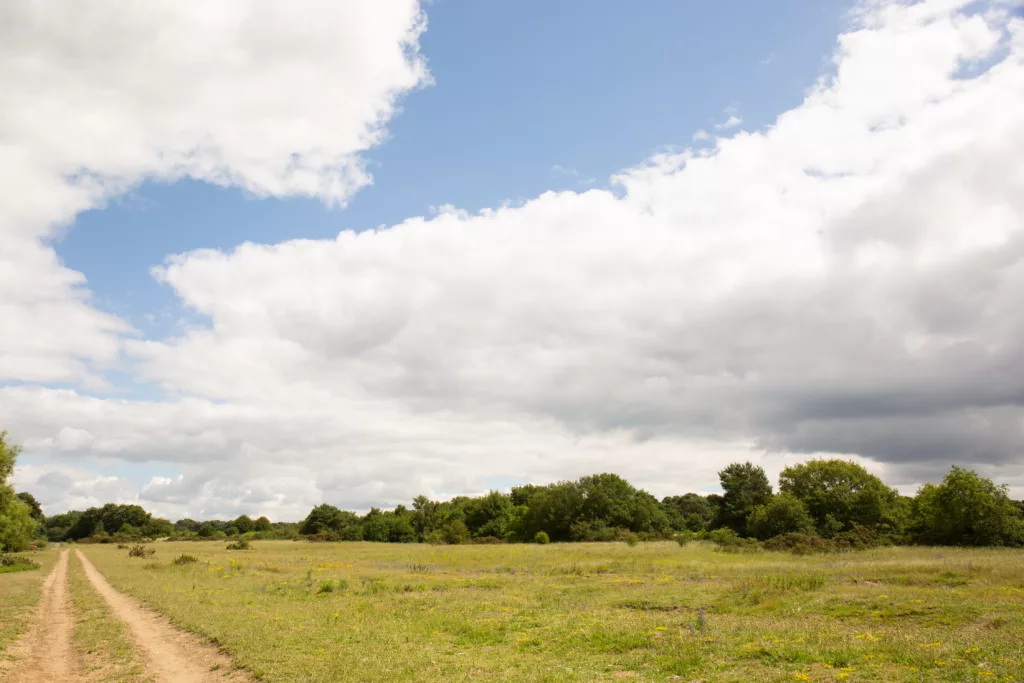
A Breckland Heath
After the First World War the British Government kicked off a massive national drive to plant huge blocks of coniferous trees for secure supplies of home-grown timber.
The sweeping sandy heathlands of the Brecks were no use for farming, good only for grazing sheep and rabbits. But they were prime real estate for millions of trees. Planting began around Thetford, eventually transforming the open grasslands to huge tracts of forest. First cleared by prehistoric farmers, wild expanses of the original heathland are rare and very special to explore.
Of the 12,550 wildlife species in the Brecks, 30% are nationally rare and some can be found only on these unique heaths. Just over the border in Suffolk is Knettishall Heath, and Norfolk’s Brettenham Heath is a 200-hectare National Nature Reserve, on chalk bedrock, tens of metres thick, laid down during the Cretaceous period.
In some places the rock is close to the surface, breaking through the sandy soil. Where the soil is thicker it also becomes slightly more acidic, subtly changing the variety of plants and wildlife. This part of Norfolk was free of ice during the most recent glacial period resembling a treeless northern tundra or steppe. Part of a mosaic of heaths, forests and farmland, Brettenham is a beautiful place for a winter walk. And if you love Geology, head for the central and eastern part of the heath, where one of the country’s best examples of acid soil and polygons of chalk can be seen.

Spoon Carving at Thetford Forest
Reconnect with the land and the wisdom of our ancestors while learning the heritage craft of wood carving. Under the expert tutorage of a Back to Wilderness bushcraft expert, you’ll carve your own wooden spoon to take home, becoming part of a time-honoured tradition for sharing and refining folk knowledge. You’ll learn how to use a variety of hand tools, gaining confidence in safe carving techniques. Discover the magic of seeing a useful tool emerge from a plain chunk of wood, celebrating the beauty in the everyday.
During this day experience you’ll be outside in the wilds of Thetford Forest, sitting amongst the quiet splendour of magnificent pine trees. Shaping an age-old natural material surrounded by the woodland which sustains the ancient rhythms of this careful work is a profoundly peaceful process.
Free of digital distractions, you’ll discover a sense of calm, deliberately connecting hand, eye and mind, feeling the warm texture of the wood, working with the patterns of its grain. As you make your hand-crafted contemporary homeware, you’ll be absorbed by the flow of a timeless craft. The word ‘spoon’ comes from ‘spōn’, Old English for ‘chip of wood’. All homes should have at least one traditionally carved wooden spoon!
This self-catered activity takes place about 10mins walk from the lodge, slightly off the beaten track. Please ask when you book, as realistic accessibility accommodations can sometimes be made. Bring a flask of soup, packed lunch and favourite snacks!
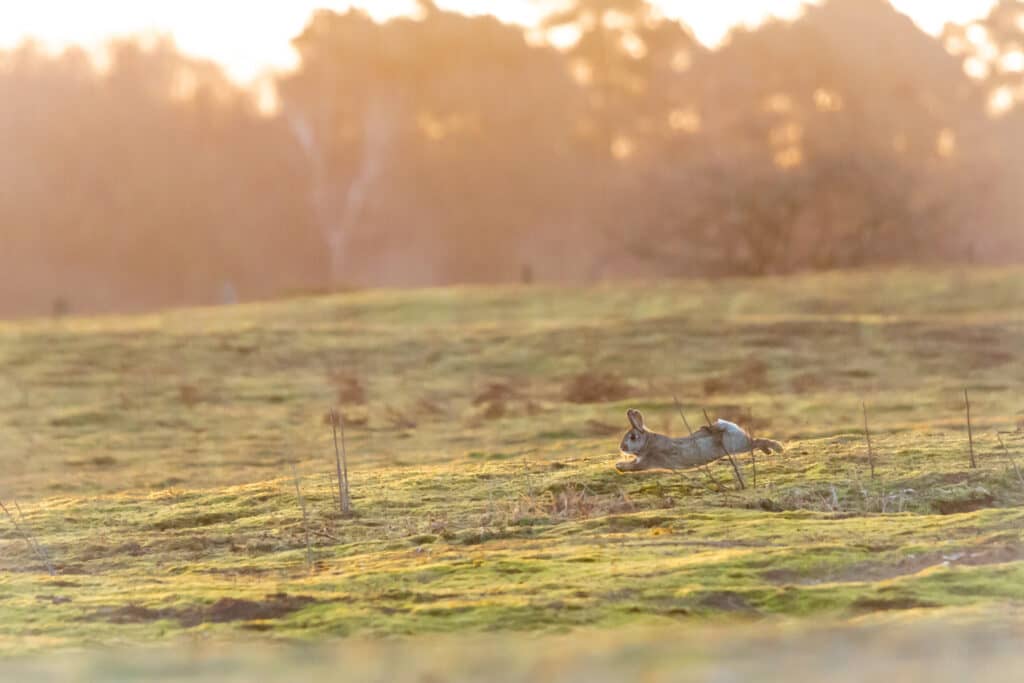
East Wretham Heath
Think of Breckland and you might picture sunlight slanting through scented pinewoods. Yet it was once a so-called ‘inland desert’, open heathland created by prehistoric farmers who felled the ancient wildwoods. A walk on East Wretham Heath takes you through the pre-forestry landscape of our ancestors. Rabbits graze among windswept grasses under a blue sky, for even in winter it rarely rains here. As one of Britain’s driest places, wild south-westerly winds once whipped up sandstorms so dramatic that, in the 1660s, they completely overwhelmed the village of Santon Downham.
Large scale pine plantations have transformed these wind scoured places into productive land and much of the open sandy Brecks has been lost. Little vegetation grows in the thin soil of the remaining pockets, so only specialist plants and animals can survive. East Wretham Heath is one such place. The Norfolk Wildlife Trust purchased the land at the start of the Second World War, making it Breckland’s oldest nature reserve, complete with gnarled Scots Pines planted at the time of Battle Waterloo. In wartime, part of the land was ploughed, now restored by careful management – and the help of local rabbits! Rabbits share the close-cropped, springy grassland with many rare plants and insects, scarce breeding birds and wily stoats with black-tipped tails and gleaming russet coats.
There are two mysterious meres (lakes), with fluctuating water levels, Ringmere and Langmere. Visit the hide at Langmere for fabulous views of migratory birds in autumn and spring.
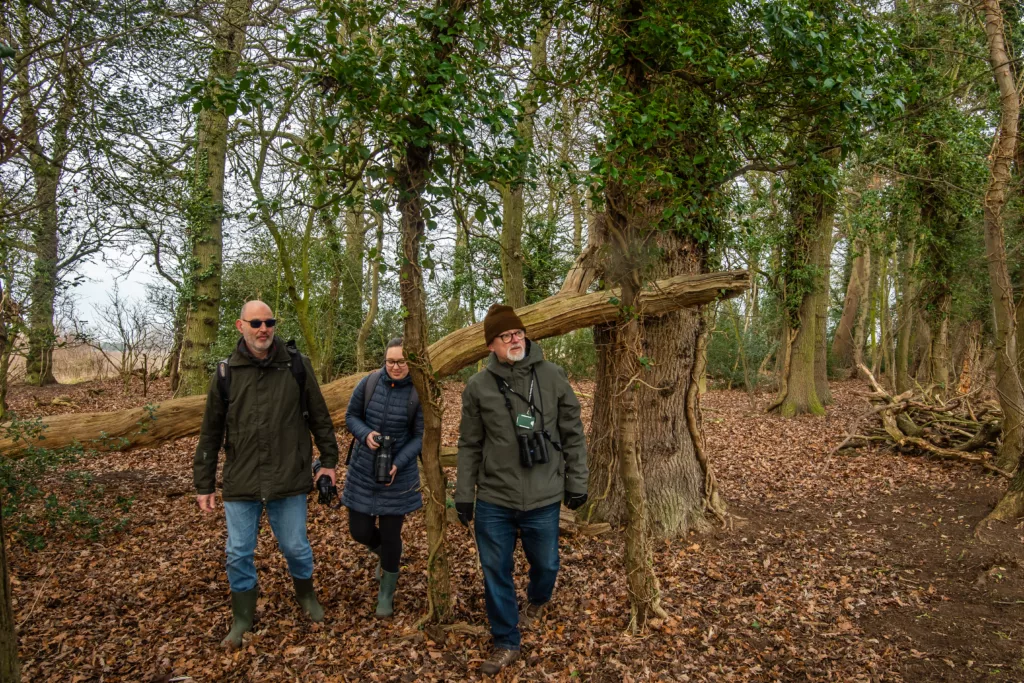
The Legend of Babes In Wayland Wood
Once upon a time all England was covered by an untamed, tangled forest. Now only pockets of ancient Wild Wood remain and to walk in them is like stepping back in time. One, mentioned in the Domesday Book, is Wayland Wood in south Norfolk. From April bluebells cover the ground amid hornbeam, oak, hazel, bird-cherry and field maple. Yellow archangel, water avens, wood anemone, early purple orchid and the rare yellow star of Bethlehem have all been found here. It’s an immensely pretty place for walks in early spring.
But in winter a more menacing atmosphere takes hold. Wayland Wood is the setting for the ‘Babes in the Wood’ and a winter walk brings the dark legend alive. An orphaned brother and sister were left in the care of their uncle at nearby Griston Hall. Should they die, this villain would inherit their father’s fortune so in the dead of winter he took them deep into Wayland Wood and abandoned them. When death came, a robin covered their frozen bodies with leaves. It’s said their little ghosts wander the wood, wailing in the dark. The oak tree where they died, huddled together, was struck by lightning in 1879.
Inside the half light of folk stories a local truth often hides. Were the babes real? Wayland Wood keeps its secrets in the shadow of oak, ash and thorn. And the Watton town sign remembers them, two shivering children under an oak tree, waiting for help that never came.
Build your own itinerary
If you fancy creating your own itinerary for a day trip to Norfolk or a longer visit, it couldn’t be simpler. Just go to Search Activities and select from our wide range of free and paid-for experiences, saving any that capture your imagination with the click of a button.
Once you’ve finished, you’ll find all the information stored in My Favourite, where you can drag and drop activities to create your own day-by-day itinerary! You can download this to a calendar and even share it with friends.
